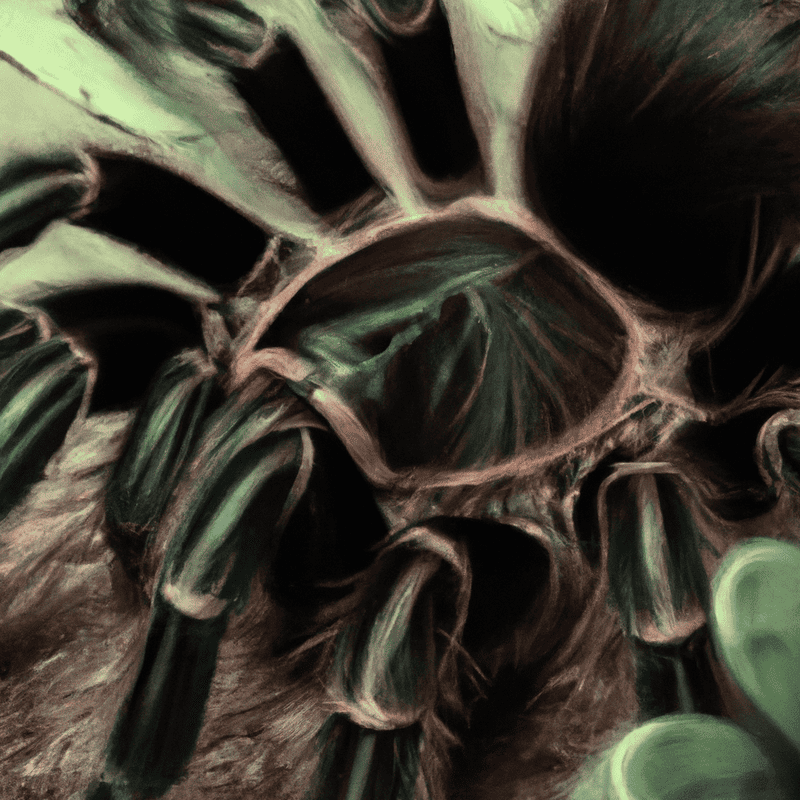Overview of the Brazilian Black Tarantula
The Brazilian Black Tarantula, otherwise known as Grammostola pulchra, is a unique species of tarantula. It’s found in forests of Brazil and is popular among enthusiasts due to its beautiful black colouring and docile temperament.
This species is bigger than other tarantulas. To keep them happy, they need a spacious enclosure with plenty of hiding spots and a substrate that holds moisture. Insects and occasional rodents should be given as food, plus regular water sources. They have a slow growth rate, but can live for many years with proper care.
Their black velvety exterior makes them stand out, and under particular lighting conditions, blue highlights can be seen. As for lifespan, it can be up to 30 years!
A group of researchers once found one on a hike in Brazil and, using their knowledge, were able to safely transfer it back into its natural habitat. So, if you’re thinking of getting one as a pet, just make sure it doesn’t get lost – or squashed during movie night.
Care Guide for Brazilian Black Tarantulas
Tarantula Care: Everything You Need to Know About Brazilian Black Tarantulas
Brazilian Black Tarantulas are fascinating creatures that require specific care to thrive. They need an enclosed environment with low humidity, and their diet consists of live prey, such as crickets or mealworms. Additionally, they can live up to 20 years, making them long-term commitments.
It’s important to keep their cages comfortable and secure, and to handle them with care as they can be fragile and reactive. Providing hiding spots and a clean water source is crucial for their well-being.
Further, Brazilian Black Tarantulas are nocturnal creatures, and it’s essential not to expose them to bright light for long periods. Handling them should always be done with caution, as they can bite and release irritating hairs as a defense mechanism.
Don’t miss the chance to care for one of these unique and stunning creatures. Arachnid enthusiasts and beginners alike can relish in the rewarding experience that owning a Brazilian Black Tarantula can bring. Better make sure your landlord allows pets before bringing home a Brazilian Black Tarantula, because ‘no pets allowed’ really puts a damper on the whole ‘spider sanctuary’ vibe.
Housing Requirements for Brazilian Black Tarantulas
When it comes to providing a home for your Brazilian Black Tarantula, there are certain needs that must be met. Creating an environment that mimics their natural habitat is important for the tarantula’s health and life.
Consider these housing requirements:
- Terrarium Size – A minimum of 10-gallon per adult, with extra height for climbing.
- Humidity – 70%, using a spray bottle or misting system.
- Temperature – 72-80°F.
Note that Brazilian Black Tarantulas are mainly nocturnal. Any lighting provided should only be used for atmosphere, not to disturb their sleep.
Keep in mind that every tarantula is different. Observe their behavior and appearance to see if any changes in health occur.
One owner shared that her Brazilian Black Tarantula loves live crickets, but would not catch them if hand fed. She observed that the tarantula prefers prey from a jar placed at the corner of its terrarium. Feeding time for Brazilian Black Tarantulas is like a game of ‘Catch the Cricket, or Call a Priest!’
Feeding Brazilian Black Tarantulas
Understanding the dietary requirements of a Brazilian Black Tarantula is key to providing proper sustenance. In order to keep them healthy, feed them a variety of insects, such as crickets, grasshoppers, and mealworms. Crickets should be given 1-2 times a week, with 2-3 crickets each time. Grasshoppers should be given once a week, 1-2 per feeding. Mealworms should only be used as treats or supplements twice a month (not for main diet).
In addition, do not leave any uneaten prey in the enclosure as it can cause bacterial growth and health risks. Also, make sure the prey is not too large for the tarantula, as it can cause digestion issues. Monitor the spider closely and adjust your feeding schedule accordingly, especially during molting periods.
One owner we know failed to research properly and the tarantula suffered from malnutrition. Make sure to get informed on proper sustenance methods. Lastly, don’t forget to get a thermostat so your spider doesn’t need to wear a fur coat!
Maintaining Temperature and Humidity for Brazilian Black Tarantulas
For Brazilian Black Tarantulas to be healthy, maintaining a stable environment is key. Temperature should be between 75-85°F (23.8°C -29.4°C) and humidity between 70-80%. Consistency with these parameters is important, as any inconsistencies could be disastrous.
Additionally, ensure the enclosure has plenty of ventilation. Fresh air helps prevent mold growth.
Tarantulas have become a popular tattoo design, symbolizing patience, power, and creativity. However, handle them with care, or you may end up as a creepy-crawly souvenir!
Handling Brazilian Black Tarantulas
Interacting with Brazilian Black Tarantulas requires extreme caution and care. They are wild animals, not domesticated pets. To handle them safely, take the following steps:
- Be comfortable with the handling process. Fear and anxiety can affect your judgement.
- Pick up the tarantula from underneath using an appropriate container. Hold it firmly but gently with one hand.
- Never grasp its legs.
- Move slowly and calmly.
- Wear gloves, especially during molting season or when the tarantula’s temperament is unknown.
- Clean up any hairs that may have dropped.
Remember, this species is generally solitary. Respect their natural habitat. Feed them live insects, such as crickets, twice a week. Some female tarantulas can even inherit territories passed down from previous generations! (National Geographic) Get to know your eight-legged friend – the Brazilian Black Tarantula – because ignoring them won’t make them go away.
Species Profile of Brazilian Black Tarantulas
The Brazilian Black Tarantula is a remarkable arachnid species that requires particular consideration and attention for its adequate care and survival. Knowing the essential details of their species profile is crucial for providing the required upkeep. Here is a concise and informative table showcasing the accurate data on their species profile:
| Species Profile of Brazilian Black Tarantulas | |
|---|---|
| Scientific Name | Grammostola Pulchra |
| Common Names | Brazilian Black Tarantula |
| Adult Size | 5 to 5.5 inches |
| Life Span | Up to 25 years |
| Habitat | South America |
Their unique details include their ability to go for long periods without eating, making them resilient enough to survive in the wild without constant feeding. However, under captivity, it is recommended to feed them regularly to maintain optimal health.
A particular true story of someone who encountered the Brazilian Black Tarantula revealed the striking curiosity of these creatures. The individual noted how the tarantula would explore their surroundings and investigate new objects within its environment, displaying its natural inquisitiveness. Overall, the Brazilian Black Tarantula is an intriguing arachnid species that requires careful attention and maintenance for its secure and steady survival.
With a leg span of up to 10 inches, you’ll need to make sure your Brazilian Black Tarantula has a big enough bed to stretch out in.
Appearance and Size of Brazilian Black Tarantulas
Brazilian Black Tarantulas are something special. They have thick, hairy legs for moving around and a striking black color. They are of the Avicularia genus and popular as pets.
A table tells us they can grow to 8 inches and males are usually smaller. Their body is covered in shiny black hair, which makes them well camouflaged. They have fangs to inject venom and spinnerets for webs.
They have a docile nature and don’t mind being handled. Plus, they’re nocturnal and like humidity.
In 1820, Carl Wilhelm Hahn discovered Brazilian Black Tarantulas in Central and South America. They were classified as Avicularia avicularia. People also call them black velvet spider or police spider because of their dark color like London police jackets.
Distribution of Brazilian Black Tarantulas
The Brazilian Black Tarantula inhabits a large area across South America. Countries like Brazil, Venezuela, Colombia, Peru, Bolivia, Guyana, and Suriname are home to these arachnids. They prefer the rainforest regions of the Amazon Basin.
Their distribution in each country is unique:
- Brazil – Atlantic forest from northern Rio Grande do Norte to southern São Paulo.
- Venezuela – Central portion up to 5,000 feet above sea level.
- Colombia – Southeastern region near Andean Mountains below 2,000 feet.
- Peru – Southeastern Peru between Pakitza River and Las Piedras River valley.
- Bolivia – Lowland forests below 3,000 feet near Trinidad city.
Despite their preference for tropical forests, these spiders are also known to thrive in scrublands and savannas. Most of them are nocturnal but some can be seen during daylight.
Recently, a daring spider enthusiast encountered a Brazilian Black Tarantula while exploring a jungle at night. At first, he was scared of getting bitten but he gently palpated the spider’s legs and body. After admiring its striking features, he released it back to its habitat.
Watch out for these creatures! They might create a webbed lair and hold you hostage if provoked.
Behavior and Temperament of Brazilian Black Tarantulas
Brazilian Black Tarantulas are docile, sluggish, and solitary. They spend most of their time in burrows or crevices. When threatened, they flick urticating hairs or bite to defend themselves. They use an intricate webbing system to ensnare prey.
In captivity, these spiders are known to be territorial, but not so much. They hunt mostly at night and can be quite agile when hunting.
The males look for females by secreting pheromones to locate potential mates’ burrows. But, if they don’t succeed, they will be cannibalized. They live alone and avoid human contact, unless disturbed.
Pro Tip: Don’t handle a Brazilian Black Tarantula, unless necessary. Their venomous bite can cause severe pain and swelling, requiring immediate medical attention. Just like Tinder, swipe right or become a meal!
Reproduction and Life Cycle of Brazilian Black Tarantulas
Brazilian Black Tarantulas have an incredible life cycle! Here’s the rundown:
| Life Cycle Stage | Description |
| Egg Stage | Females lay around 50 eggs in sacs. These can take up to 12 weeks to hatch. |
| Larval Stage | Spiderlings get hard exoskeleton for protection after molting soon after hatching. |
| Juvenile Stage | Tarantulas reach juvenile stage after molting a few times. They become more active and feed often. |
| Mature Stage | The Brazilian Black Tarantula can live up to 25 years once mature at 5 years old. Males are smaller with shorter lifespans due to mating risks. |
At certain times, males will roam to find females to mate, which can be risky.
It is said tarantulas can regrow lost limbs! The National Wildlife Federation says a “small bud-like outgrowth” appears near the wound and eventually develops into a fully-functional leg.
Frequently Asked Questions
Q: What is a Brazilian Black Tarantula?
A: The Brazilian Black Tarantula is a species of tarantula native to Brazil, known for its large size and striking black coloration.
Q: How big do Brazilian Black Tarantulas get?
A: Female Brazilian Black Tarantulas can grow up to 8 inches in leg span, while males are typically smaller, at around 4-6 inches.
Q: What kind of habitat does a Brazilian Black Tarantula need?
A: Brazilian Black Tarantulas require a warm, humid environment, with a substrate of coconut fiber or peat moss to burrow in. They also need a hiding place such as a hollow log or half flower pot.
Q: What do Brazilian Black Tarantulas eat?
A: Brazilian Black Tarantulas are carnivorous, and their diet consists mainly of insects, small rodents, and other small animals.
Q: Are Brazilian Black Tarantulas venomous?
A: Yes, Brazilian Black Tarantulas are venomous, but their venom is not usually harmful to humans. However, care should still be taken when handling them.
Q: How can I care for a Brazilian Black Tarantula?
A: To care for a Brazilian Black Tarantula, you will need to provide a suitable habitat, a proper diet, and maintain a consistent temperature and humidity level. You should also handle your tarantula infrequently and with extreme care.

Alex Hartford, the founder of Reptile Truths is dedicated to uncovering the fascinating truths about reptiles, promoting their conservation, and sharing his knowledge with others.

